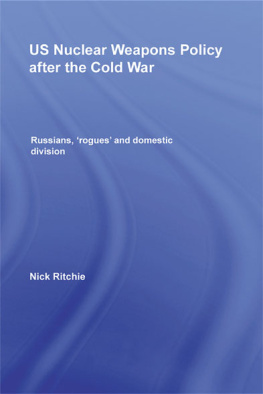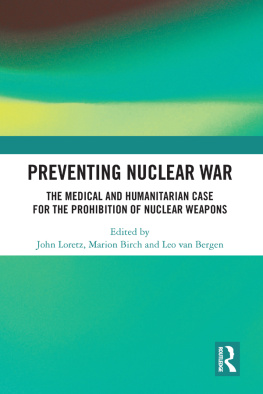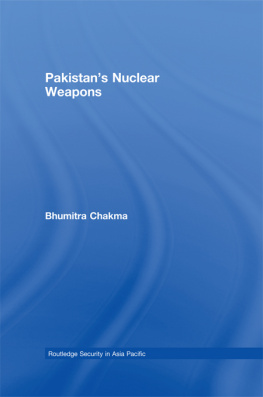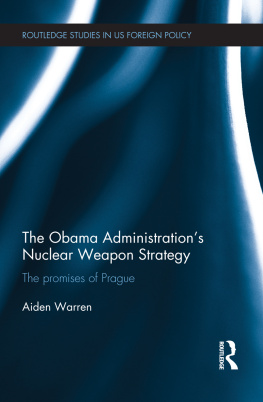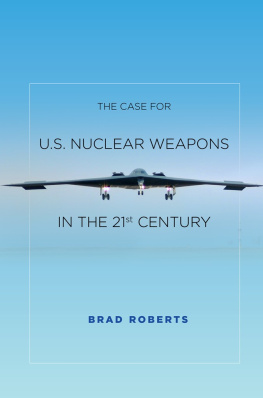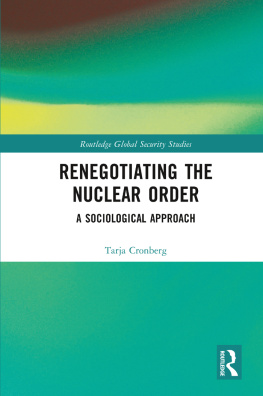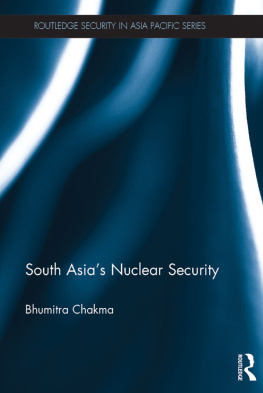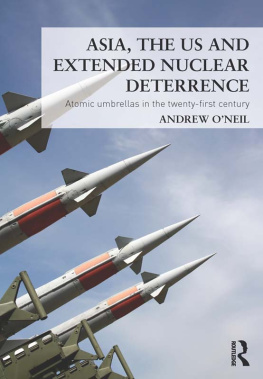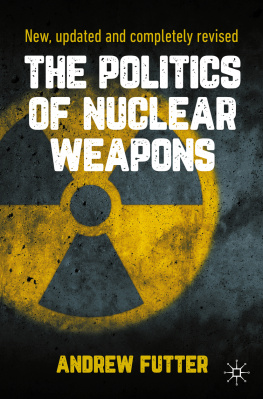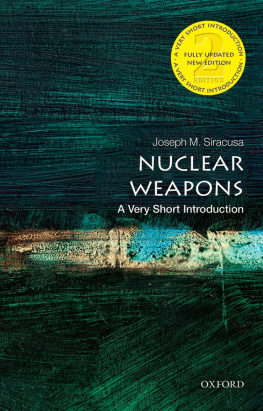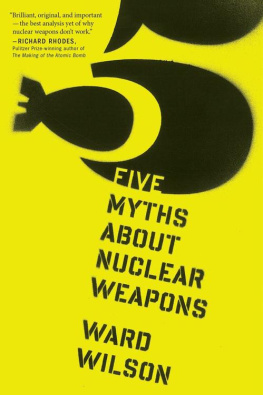The Treaty Prohibiting Nuclear Weapons
This book chronicles the genesis of the negotiations that led to the Treaty on the Prohibition of Nuclear Weapons (TPNW), which challenged the established nuclear order.
The work provides readers with an authoritative account of the complex evolution of the Humanitarian Initiative (HI) and the negotiation history of the TPNW. It includes a close analysis of internal strategy documents and communications in the authors possession which trace the tactical and political decisions of a small group of state actors. By demonstrating the unacceptable humanitarian consequences and uncontrollable risks that these weapons pose to everyones security, the HI convinced many states to ban nuclear weapons and reject the policy of nuclear deterrence as unsustainable and illegitimate. As such, this book is a case-study of multilateral diplomacy and cooperation between state and civil society actors. It also contains a full discussion of both sides of the nuclear argument and assesses the extent to which the HI and the TPNW have moved the dial and presented opportunities for transformational change.
This book will be of much interest to students of nuclear disarmament, arms control and non-proliferation, diplomacy, global governance and international relations in general.
Alexander Kmentt is Director for Disarmament, Arms Control and Non-Proliferation in the Austrian Ministry for Foreign Affairs. From 20162019 he served as Austrias Permanent Representative to the Political and Security Committee of the European Union. He is one of the architects of the Humanitarian Initiative that lead to the TPNW.
Routledge Global Security Studies
Global Security Studies emphasizes broad forces reshaping global security and the dilemmas facing decision-makers the world over. The series stresses issues relevant in many countries and regions, accessible to broad professional and academic audiences as well as to students, and enduring through explicit theoretical foundations.
Series Editors: Aaron Karp and Regina Karp
Confrontational and Cooperative Regional Orders
Managing Regional Security in World Politics
Ariel Gonzalez Levaggi
Military Coercion and US Foreign Policy
The Use of Force Short of War
Edited by Melanie W. Sisson, James A. Siebens, and Barry M. Bleachman
Expanding US Military Command in Africa
Elites, Networks and Grand Strategy
Edited by Tshepo Gwatiwa and Justin van der Merwe
Nuclear Weapons Free Zones
A Comparative Perspective
Exequiel Lacovsky
Renegotiating the Nuclear Order
A Sociological Approach
Tarja Cronberg
The Treaty Prohibiting Nuclear Weapons
How it was Achieved and Why it Matters
Alexander Kmentt
For more information about this series, please visit: www.routledge.com/Routledge-Global-Security-Studies/book-series/RGSS
First published 2021
by Routledge
2 Park Square, Milton Park, Abingdon, Oxon OX14 4RN
and by Routledge
52 Vanderbilt Avenue, New York, NY 10017
Routledge is an imprint of the Taylor & Francis Group, an informa business
2021 Alexander Kmentt
The right of Alexander Kmentt to be identified as author of this work has been asserted by him in accordance with sections 77 and 78 of the Copyright, Designs and Patents Act 1988.
All rights reserved. No part of this book may be reprinted or reproduced or utilised in any form or by any electronic, mechanical, or other means, now known or hereafter invented, including photocopying and recording, or in any information storage or retrieval system, without permission in writing from the publishers.
Trademark notice: Product or corporate names may be trademarks or registered trademarks, and are used only for identification and explanation without intent to infringe.
British Library Cataloguing-in-Publication Data
A catalogue record for this book is available from the British Library
Library of Congress Cataloging-in-Publication Data
A catalog record for this book has been requested
ISBN: 978-0-367-53194-2 (hbk)
ISBN: 978-0-367-53195-9 (pbk)
ISBN: 978-1-003-08087-9 (ebk)
Typeset in Times New Roman
by Apex CoVantage, LLC
For Rebecca
Contents
PART I
The Humanitarian Initiative: 20102017: building momentum
1 The origins of the Humanitarian Initiative
2 The game needs to change
3 2015: the momentum gathers
PART II
The ban treaty is coming
4 2016: achieving a negotiation mandate
5 2017: negotiating the TPNW
PART
III The contest of arguments
6 Human security, empowerment and challenging the nuclear status quo
7 Countering the humanitarian initiative and the ban
PART IV
TPNW impact and outlook
8 What does the TPNW represent and what is its impact?
Post scriptum: some final thoughts on constructive engagement and bridge building
- Part I The Humanitarian Initiative: 20102017: building momentum
- 1 The origins of the Humanitarian Initiative
- 2 The game needs to change
- 3 2015: the momentum gathers
- Part II The ban treaty is coming
- 4 2016: achieving a negotiation mandate
- 5 2017: negotiating the TPNW
- Part III The contest of arguments
- 6 Human security, empowerment and challenging the nuclear status quo
- 7 Countering the humanitarian initiative and the ban
- Part IV TPNW impact and outlook
- 8 What does the TPNW represent and what is its impact?
- Post scriptum: some final thoughts on constructive engagement and bridge building
Guide
I am privileged to work as a diplomat in an area that is as fascinating and of such truly fundamental importance as nuclear disarmament, arms control and non-proliferation. Through my work in the Austrian Foreign Ministry, I feel I have been able to make a contribution to solving the nuclear weapons issue. This is what the Humanitarian Initiative and the Treaty on the Prohibition of Nuclear Weapons are all about. In 2019, I was granted a leave of absence from the Austrian Foreign Ministry to take up a senior visiting research fellowship at Kings College London, for which I am grateful. The time away from active diplomacy allowed me to write this book and record the history of the Humanitarian Initiative and the Treaty on the Prohibition of Nuclear Weapons.
My research fellowship at Kings College London and hence the work on this book has been made possible with generous funding from the Carnegie Corporation New York. I received additional generous financial support for this book and a series of workshops from the Friedrich Ebert Foundation, Federal Republic of Germany. I am grateful for additional generous funding provided to me by the Austrian Red Cross. Through the kind recommendation of Kazumi Matsui, Major of the City of Hiroshima, I received further generous funding from Mr. Koji Matsuo, Chairperson of the NPO Music brings Peace and Counselor of Calbee, Inc. I am honoured by the confidence that these funding institutions have placed in me.
I am grateful for the permissions to use epigrams that were granted by Taylor & Francis, the Norwegian Academy of International Law (NAIL), the Friedrich-Ebert-Stiftung (FES), the International Campaign for the Abolition of Nuclear Weapons (ICAN), as well as from Lord Browne of Ladyton, Ambassador Jorge Lomonaco and Richard Lennane. I would also like to thank the Historical Archive of the Government of Norway.


